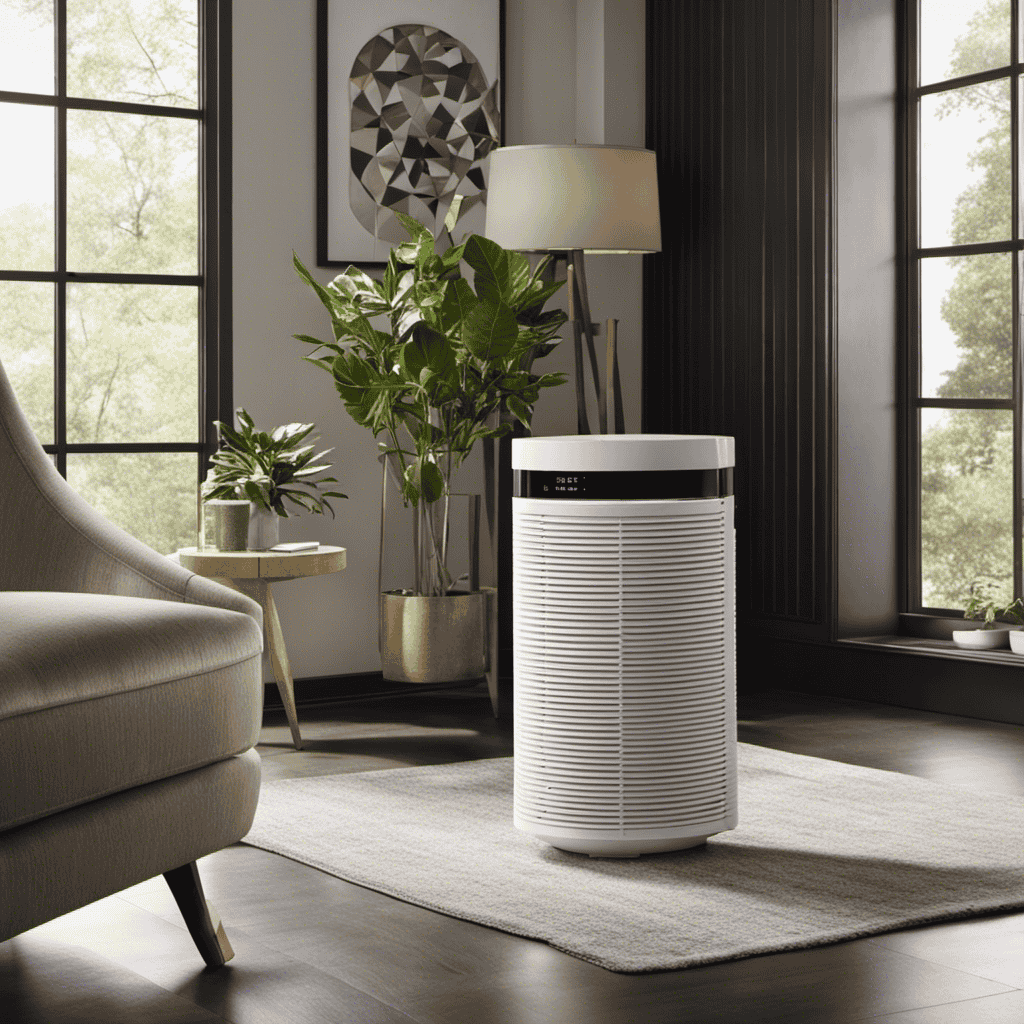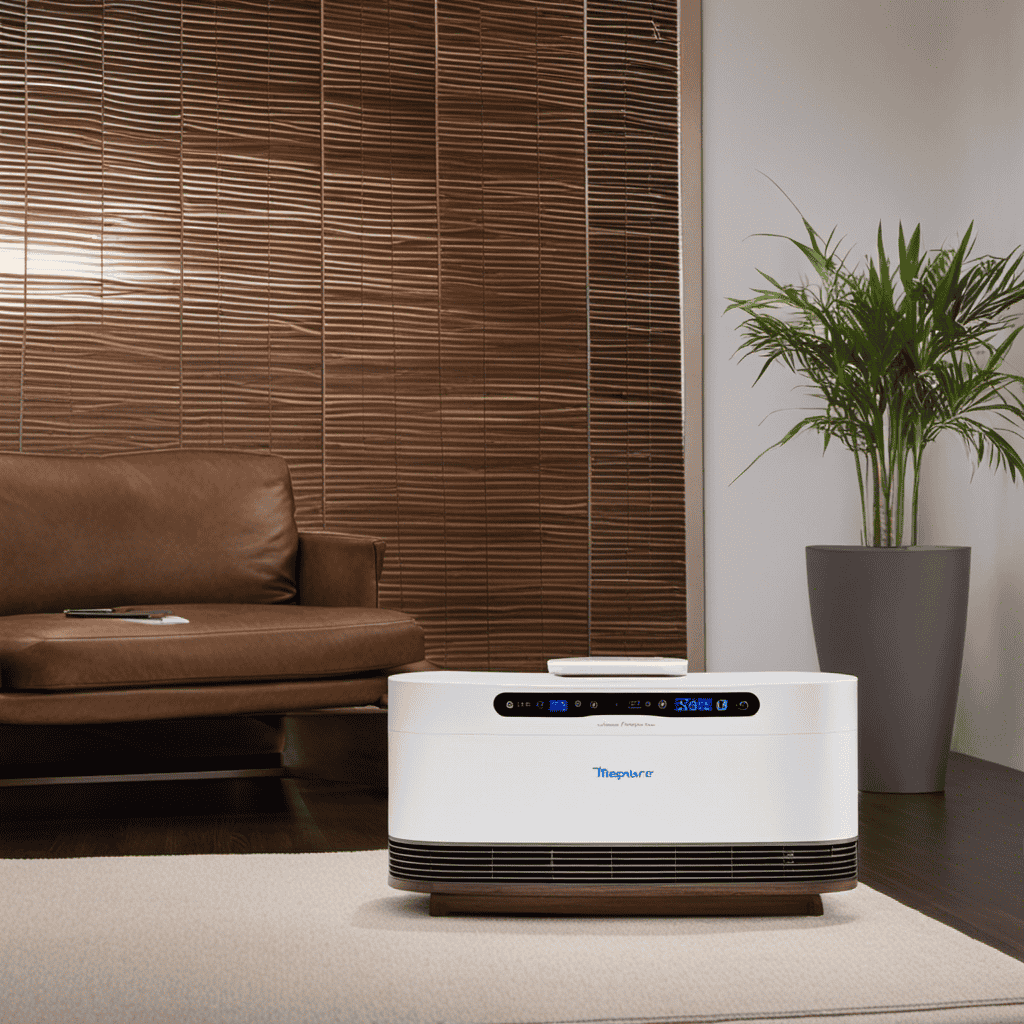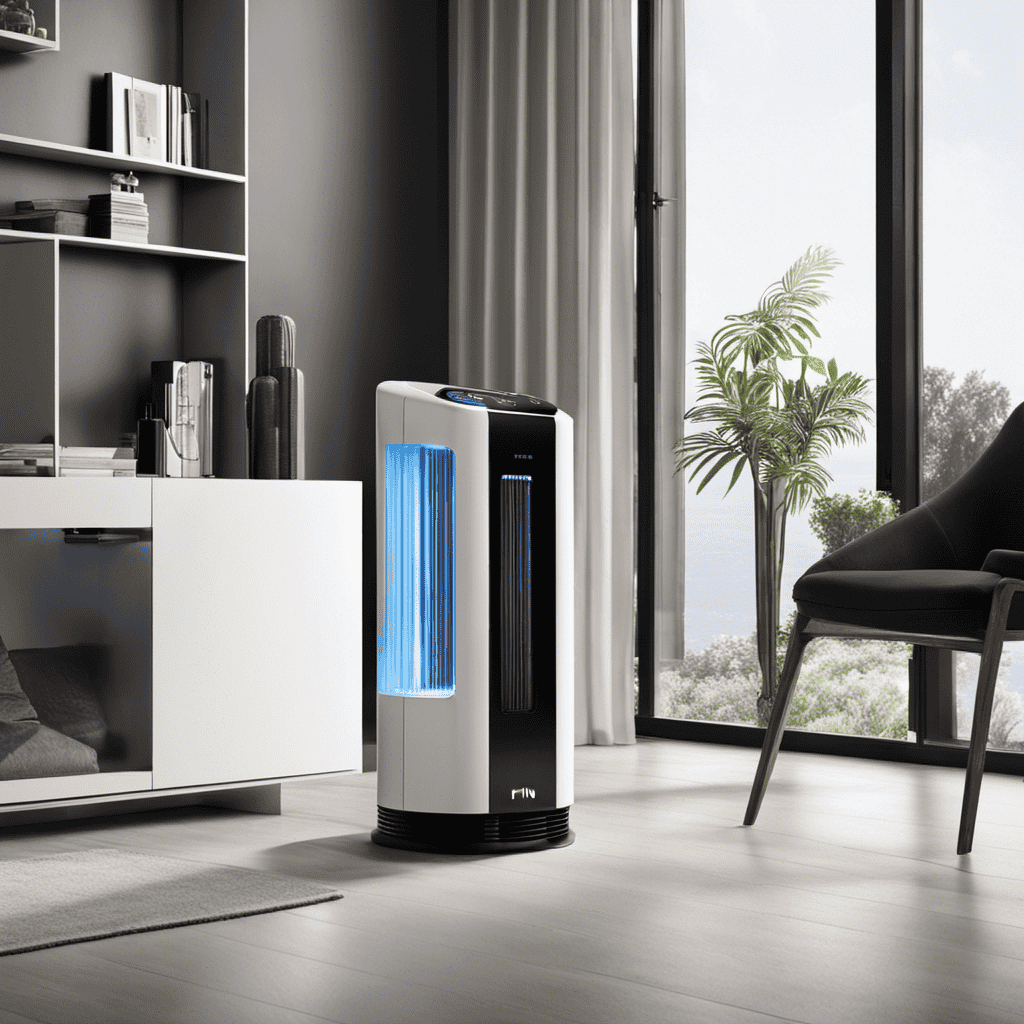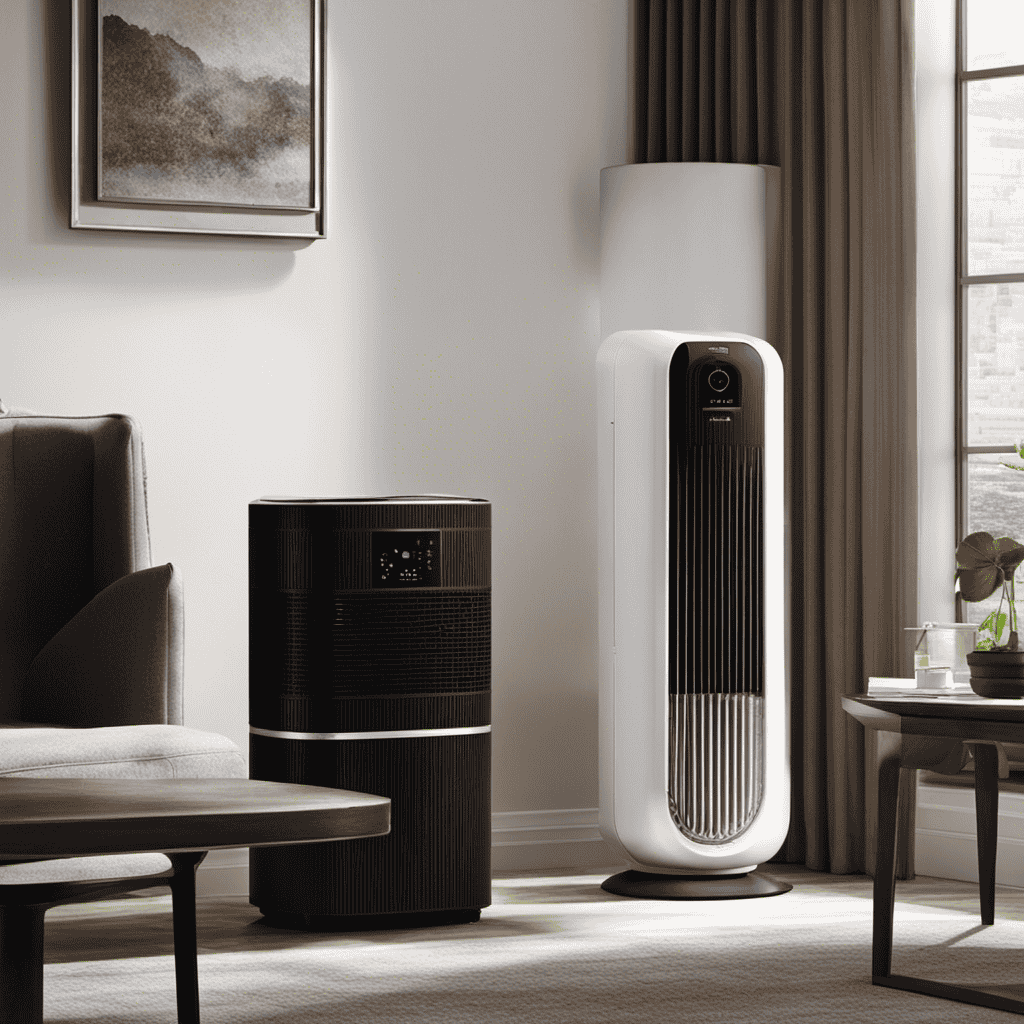I have to say, everyone, when discussing air purifiers, my main concern always revolves around safety. After all, who’s keen on inhaling all those unpleasant pollutants and allergens, correct?
That’s why I’ve done my research and compiled this comprehensive guide on the safest types of air purifiers out there. From HEPA filters, the gold standard in air purification, to UV-C light that zaps germs and bacteria, we’ll explore all the options to help you make the best choice for cleaner, healthier air.
So, let’s dive in, shall we?
Key Takeaways
- HEPA filters are the gold standard in air purification as they can trap and remove 99.97% of particles 0.3 microns or larger, making them highly beneficial for those with allergies, asthma, or respiratory conditions.
- Carbon filters are effective in capturing and neutralizing odorous molecules and harmful chemicals, improving air quality and eliminating unpleasant smells.
- Proper ventilation, regular cleaning, and natural odor absorbers like baking soda or activated charcoal can also help eliminate odors in a living space.
- UV-C light is effective in killing germs, bacteria, and mold, reducing the spread of airborne illnesses and improving indoor air quality, although safety concerns should be considered.
HEPA Filters: The Gold Standard
If you want the gold standard in air purification, you should go for an air purifier with a HEPA filter. HEPA stands for High Efficiency Particulate Air and these filters are designed to trap and remove 99.97% of particles that are 0.3 microns or larger in size.
This level of effectiveness makes HEPA filters highly beneficial for those with allergies, asthma, or other respiratory conditions. They can effectively remove allergens such as pollen, pet dander, dust mites, and mold spores from the air, improving indoor air quality and promoting better respiratory health.
HEPA filters are also effective in capturing harmful particles like bacteria, viruses, and smoke particles, making them an excellent choice for anyone concerned about airborne contaminants.
Carbon Filters: Eliminating Odors and Chemicals
When it comes to eliminating odors and chemicals from the air, carbon filters are a popular choice. These filters are designed to capture and neutralize odorous molecules and harmful chemicals, making the air cleaner and more pleasant to breathe.
The efficiency of carbon filters in removing these pollutants depends on factors like the type and quality of the carbon used, contact time between the air and the carbon, and the overall design of the filtration system.
Odor Elimination Techniques
One of the most effective ways to eliminate odors is by using an air purifier with activated carbon filters. These filters are designed to trap and remove odor-causing molecules from the air, leaving your space smelling fresh and clean. The activated carbon in the filters acts as a sponge, absorbing odorous compounds and preventing them from circulating in the air.
In addition to using air purifiers, there are other odor elimination techniques that can be employed, including:
- Regular cleaning and maintenance of your living space
- Proper ventilation to allow fresh air to circulate
- Using natural odor absorbers like baking soda or activated charcoal
- Identifying and removing the source of the odor
- Keeping your space well-ventilated and free from excessive moisture
It’s important to note that while these odor elimination techniques are generally safe, some odor-causing compounds may pose potential health risks. Therefore, it’s always advisable to consult with a professional if you have concerns about specific odors or their potential health effects.
Chemical Filtration Efficiency
The activated carbon filters in air purifiers are highly effective at trapping and removing odor-causing molecules from the air. These filters work by adsorbing the molecules onto their surface, preventing them from circulating back into the air. However, it’s important to note that not all air purifiers are created equal when it comes to their chemical filtration efficiency. To help you understand the differences, I have prepared a table comparing the effectiveness and potential drawbacks of different types of air purifiers:
| Type of Air Purifier | Effectiveness | Potential Drawbacks |
|---|---|---|
| Activated Carbon | High | Limited lifespan, may release captured pollutants when saturated |
| HEPA | Moderate | Ineffective against odors and chemical pollutants |
| UV-C | Low | Ineffective against odors and larger particles |
As you can see, while activated carbon filters are highly effective at removing odors, they do have a limited lifespan and may release captured pollutants when saturated. It’s important to consider these factors when choosing the safest air purifier for your needs.
UV-C Light: Killing Germs and Bacteria
UV-C light is effective at killing germs and bacteria, making it a safe option for an air purifier. Here are some key points about its effectiveness and safety concerns:
- UV-C light has been proven to effectively eliminate harmful microorganisms, including bacteria, viruses, and mold.
- It works by damaging the DNA and RNA of these pathogens, preventing them from reproducing and causing infections.
- UV-C light is particularly effective against drug-resistant bacteria, offering a solution to the growing problem of antibiotic resistance.
- When used in air purifiers, UV-C light can help reduce the spread of airborne illnesses and improve indoor air quality.
Safety concerns with UV-C light mainly revolve around direct exposure to the skin and eyes, which can cause burns and damage. However, modern air purifiers incorporate safety features to minimize these risks.
Electrostatic Precipitators: Capturing Particles With Static Electricity
In my previous subtopic, we discussed UV-C light as a method for killing germs and bacteria in the air. Now, let’s explore another air purification technique called Electrostatic Precipitators. These devices work by capturing particles using static electricity.
Electrostatic precipitators are equipped with an ionizer that charges the particles in the air. The charged particles then pass through a series of plates with an opposite charge, causing them to stick to the plates. This process effectively removes particles from the air, including dust, smoke, and pollen.
To give you a better understanding, here is a comparison table showcasing the differences between UV-C light and Electrostatic Precipitators:
| UV-C Light | Electrostatic Precipitators | |
|---|---|---|
| Principle | Kills germs with UV-C light | Captures particles using static electricity |
| Odor Elimination Techniques | Limited effectiveness | Can effectively remove odors |
| Potential Health Risks | UV-C light exposure may be harmful | Ozone production can be a concern |
While Electrostatic Precipitators can effectively eliminate odors, it’s important to note that they may produce ozone as a byproduct, which can be a potential health risk. Therefore, it is crucial to choose an electrostatic precipitator that meets safety standards and minimizes ozone production.
Ozone Generators: The Controversial Option
Ozone generators, although controversial, are sometimes used as an alternative for air purification. While they can be effective in eliminating odors and killing certain types of bacteria, there are potential dangers associated with their use.
Scientific evidence suggests that ozone, when inhaled, can irritate the respiratory system and cause adverse health effects. It can also react with other chemicals in the air to form harmful byproducts.
Here are some important points to consider:
- Ozone generators produce ozone, a highly reactive gas
- Inhaling ozone can cause respiratory irritation and other health problems
- Ozone can react with chemicals in the air to form harmful byproducts
- Scientific studies have linked ozone exposure to asthma and other respiratory conditions
- Ozone generators should be used with caution and in well-ventilated areas.
Given the potential dangers of ozone generators, it is important to explore safer alternatives such as activated charcoal for air purification.
Activated Charcoal: Absorbing Volatile Organic Compounds
Activated charcoal is a popular choice for absorbing volatile organic compounds (VOCs) in the air. It has been widely used for air purification due to its numerous benefits.
One of the main advantages of activated charcoal is its ability to effectively trap and remove harmful pollutants from the air. This is achieved through a process called adsorption, where the charcoal particles attract and bind to the VOCs, preventing them from circulating in the air. Activated charcoal is highly porous, providing a large surface area for the adsorption process to occur.
This makes it an efficient and effective method for improving indoor air quality. When compared to other air purification techniques, activated charcoal stands out for its natural and non-toxic properties, making it a safe and eco-friendly option for reducing indoor air pollution.
Ionizers: Producing Negative Ions for Cleaner Air
When it comes to ionizers, there is a debate surrounding their effectiveness in improving air quality. Some studies suggest that ionizers can remove particulate matter from the air, while others question their ability to effectively remove harmful pollutants.
Additionally, potential health risks associated with ionizers, such as ozone production, are a concern for many individuals.
In order to evaluate the benefits and drawbacks of ionizers, it is important to compare them to other air purification methods, such as filters, to determine which option is the most effective and safe for improving indoor air quality.
Ionizer Effectiveness Debated
If you’re considering an ionizer, it’s important to note that the effectiveness of ionizers in purifying the air is still a topic of debate. While some studies suggest that ionizers can effectively remove pollutants from the air, others argue that the negative ions produced by ionizers may not have a significant impact on air quality.
Here are some key points to consider when evaluating the effectiveness of ionizers:
-
Ionizer safety concerns: Some experts raise concerns about the potential release of ozone and other harmful byproducts when using ionizers. It is important to choose an ionizer that meets safety standards and does not produce excessive amounts of ozone.
-
Ionizer vs. HEPA filters: HEPA filters are known for their high efficiency in capturing airborne particles, including allergens and pollutants. In comparison, ionizers work by releasing negative ions that attach to particles, causing them to fall to the ground. However, the effectiveness of ionizers in removing smaller particles may be limited.
-
Room size and placement: The effectiveness of an ionizer can be influenced by factors such as room size and placement. It is recommended to use ionizers in smaller rooms and place them in areas with proper air circulation.
-
Maintenance and cleaning: Regular maintenance and cleaning are essential to ensure optimal performance of ionizers. Filters should be replaced or cleaned according to the manufacturer’s instructions.
-
Personal preference and sensitivity: Some individuals may find that ionizers provide noticeable improvements in air quality, while others may not experience the same benefits. Personal preference and sensitivity to air pollutants should be taken into consideration when deciding whether to use an ionizer.
Overall, it is important to weigh the potential benefits and limitations of ionizers before making a decision. Consulting with experts and considering individual circumstances can help determine the best air purification solution for your needs.
Potential Health Risks
To minimize potential health risks, consider researching the ionizer model you’re interested in and reading reviews from other users.
It is essential to prioritize the safety of your indoor environment, especially when it comes to air quality. While ionizers can effectively remove pollutants from the air, there are concerns about the release of ozone, which can lead to respiratory issues and exacerbate existing conditions like asthma.
It is vital to choose an ionizer that meets air quality standards and has been tested for ozone emission levels. Look for models that are certified by reputable organizations like the California Air Resources Board (CARB) or the Association of Home Appliance Manufacturers (AHAM).
These certifications ensure that the ionizer complies with strict regulations and poses minimal health risks.
Comparing Ionizers to Filters
Comparing ionizers with filters can help you determine which option is more effective at removing pollutants from the air. When it comes to air purification, there are some key differences between HEPA filters and ionizers. Here’s what you need to know:
-
HEPA filters:
-
Highly effective at capturing particles as small as 0.3 microns.
-
Removes allergens, dust, pet dander, and pollen.
-
Traps particles in a physical filter.
-
Does not produce any harmful byproducts.
-
Requires regular filter replacement.
-
Ionizers:
-
Emit negative ions into the air.
-
Attract and attach to airborne particles, making them fall to the ground or stick to surfaces.
-
Can help reduce odors.
-
Some concerns about ozone production and potential health risks.
-
No need for filter replacement.
When it comes to safety concerns, it’s important to consider the potential risks associated with ionizers, such as ozone production. HEPA filters, on the other hand, are considered safe and reliable for air purification.
Ultimately, the choice between a HEPA filter and an ionizer depends on your specific needs and preferences.
Plasmacluster Technology: Neutralizing Harmful Substances
You should consider the plasmacluster technology air purifiers as they effectively neutralize harmful substances in the air.
Plasmacluster technology, developed by Sharp Corporation, is a unique air purification technology that uses positive and negative ions to eliminate pollutants. These ions are generated by a plasma discharge, simulating the natural ionization process that occurs in nature.
Plasmacluster technology has a wide range of applications, including air purifiers, refrigerators, and even cars. It works by releasing both positive and negative ions into the air, which attach themselves to harmful substances such as bacteria, viruses, mold spores, and allergens. This causes these substances to break down and become inactive, resulting in cleaner and fresher air.
Safety concerns regarding plasmacluster technology have been addressed through rigorous testing and certification. Independent studies have shown that plasmacluster technology is safe for use by humans and animals, with no adverse effects reported.
Frequently Asked Questions
Are Air Purifiers With HEPA Filters Effective in Removing Allergens Like Pollen and Pet Dander?
Yes, air purifiers with HEPA filters are effective in removing allergens like pollen and pet dander. They capture particles as small as 0.3 microns, improving indoor air quality without producing harmful ozone.
How Long Does a Carbon Filter Typically Last Before It Needs to Be Replaced?
When it comes to the lifespan of a carbon filter, it’s important to know the signs of wear. Over time, a worn out filter may no longer effectively remove pollutants, compromising the air quality in your home.
Can UV-C Light in Air Purifiers Kill Viruses Like the Flu or Covid-19?
UV-C light in air purifiers can effectively kill viruses like the flu or COVID-19. However, when it comes to the safest type of air purifier, it’s important to consider the effectiveness of UV-C light against bacteria and mold compared to other types.
Do Electrostatic Precipitators Produce Any Harmful Byproducts or Ozone?
As an air purifier enthusiast, I’ve researched if electrostatic precipitators emit ozone and the potential health risks. It’s important to understand the safety of all types of air purifiers before making a decision.
How Does Activated Charcoal in Air Purifiers Help in Reducing Odors and Volatile Organic Compounds (Vocs)?
Activated charcoal in air purifiers helps reduce odors and volatile organic compounds (VOCs) by adsorbing them onto its porous surface. This enhances air purifier effectiveness and creates a safer indoor environment.
Conclusion
In conclusion, when it comes to choosing the safest type of air purifier, the HEPA filter stands out as the gold standard.
With its ability to capture even the tiniest particles, it ensures cleaner and healthier air for you and your loved ones.
Imagine a serene and pristine forest, where every breath fills your lungs with pure freshness. That’s the kind of air you can experience with a HEPA filter air purifier.
So choose wisely, and let the magic of HEPA filters transform your indoor air quality.










